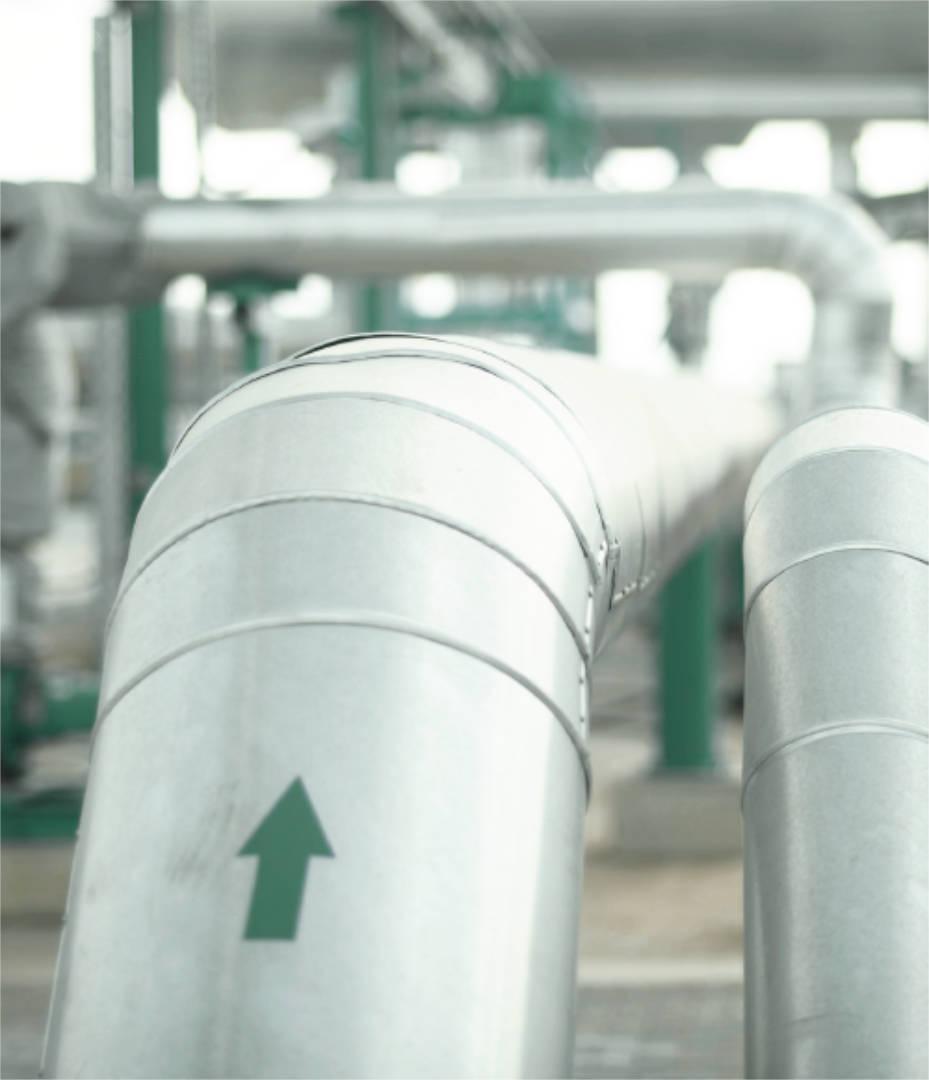- Application
- /
- HEAT RECOVERY FROM POWER STATION

Waste heat recovery in power plants and Oil&Gas industry
Recovering exhaust heat from gas turbines and internal combustion engines is an effective way to optimise efficiency and performance, while reducing the environmental impact of power generation plants commonly used for processing and refining in the Oil & Gas sector, as well as electricity production stations. Waste heat recovery systems that repurpose this waste heat by converting it into clean electricity are the key technology to achieve this goal.

MAPPING THE PATH TO A SUSTAINABLE FUTURE THROUGH WASTE HEAT RECOVERY
ORC vs. Steam Rankine Cycle for Waste Heat Recovery: How to Choose?
When it comes to available technologies to recover waste heat from these sources, the market offers two commercial solutions: steam technologies and Organic Rankine Cycle systems.
Waste Heat Recovery plants employing steam offer advantages in terms of both efficiency and security for plant operation but lack flexibility and require more maintenance compared to ORCs.
The Organic Rankine Cycle (ORC) offers the advantages of higher flexibility, as well as less and simpler maintenance, making it the preferred choice for exhaust gas heat recovery from both engines and gas turbines in the low-medium size range.
Why choose an ORC system for exhaust heat recovery from turbines and engines?
1
INCREASED POWER STATION EFFICIENCY
Waste heat helps to achieve the highest power conversion cycle efficiency.
2
REDUCED FOSSIL FUEL CONSUMPTION
Waste heat recovery plants reduce the use of fossil fuels (coal, oil, gas) to achieve higher power output from turbines and engines.
3
REDUCED CARBON FOOTPRINT:
Waste heat recovery systems produce power from exhaust heat downstream turbines and engines, avoiding the use of polluting fossil fuels responsible for NOx, SOx and CO2 emissions in the atmosphere.
4
ACCESS TO ELECTRICITY WITH REDUCED DEPENDENCY ON THE ELECTRICAL GRID
Waste heat recovery power plants produce electricity that can be directly employed for power needs. This represents an advantage in the form of easier and more reliable access to electricity for remote or isolated sites with difficult grid access.
Advantages of ORC Waste Heat Recovery Systems vs Steam Rankine Cycle:
1
SIMPLE PLANT DESIGN

Competitive capital cost leading to fast payback
2
COMPACT AND AUTOMATED SOLUTION

No need for operators, which reduces operating costs
3
FLEXIBILITY OF PLACEMENT AWAY FROM THE HEAT SOURCE IF REQUIRED

More freedom of placement based on available space and production process requirements
4
FAST START UP AND SHUTDOWN

High availability in operation

Easy maintenance
5
NO WATER TREATMENT PLANT OR MAKEUP WATER REQUIRED

No need for water consumption

Higher sustainability
6
HIGH EFFICIENCY (UP TO 40%) AT A VARIETY OF OPERATING TEMPERATURES AND LOADS

Possibility to exploit the maximum energy available from the process
Exergy's ORC application for O&G Waste Heat Recovery
Exergy ORC waste heat recovery systems employing the Radial Outflow Turbine offer high efficiency for modern low temperature turbines, in addition to all the advantages of ORC vs steam.
APPLICATIONS





EXAMPLE of performance and payback time from 7 gas engines mod. Rolls Royce B35:40 V20AG2 | operational load 100% | fuel: natural gas
| 50, 400 kg/h | 380 °C | 140 °C | 25.3 MWT | 5.5 MWe | 3 years | less than 2 years |
|---|---|---|---|---|---|---|
| EXHAUST GAS MASS FLOW RATE (EACH ENGINE) | EXHAUST GAS TEMPERATURE | WHR OUTLET EXHAUST GAS TEMPERATURE | RECOVERED THERMAL POWER | GENERATED POWER | PAYBACK TIME (100USD/MWh) | PAYBACK TIME (200USD/MWh) |
EXERGY’s ORC power plants range between 1 MW to 20 MWe for a single unit.
Want to Know How Our Waste Heat Recovery Systems Can Improve the Efficiency and Sustainability of Your Processes?

PORTFOLIO
6 MWe

PLANTS
10

TOE/Y SAVED
9100

TONNES CO2 EMISSION/Y SAVED
17800
How Waste Heat Recovery cycle from gas turbine or engine works
The heat recovery system extracts thermal power from the exhaust of engines or turbines to feed the ORC module via an intermediate loop of heat recovery. The intermediate fluid, usually oil, transfers heat to the organic fluid in the ORC evaporator, where it vaporizes. The vaporized fluid then flows to the turbine. Here, the vapor expands, causing the turbine to spin and creating electricity in the generator.
The vaporized organic fluid then continues through the cycle to the condenser where it transforms into liquid, ready to be processed by the pump before beginning the cycle again.



